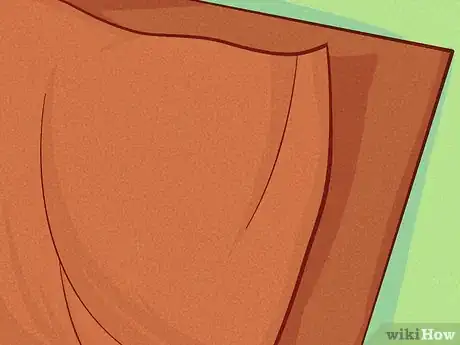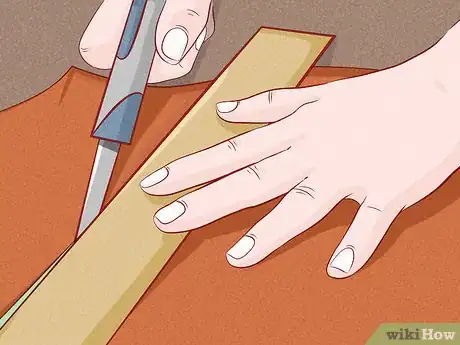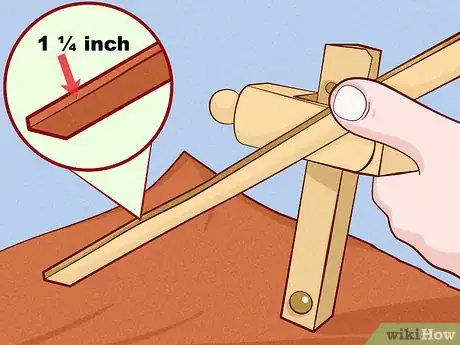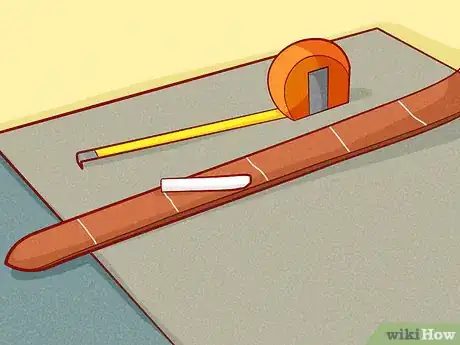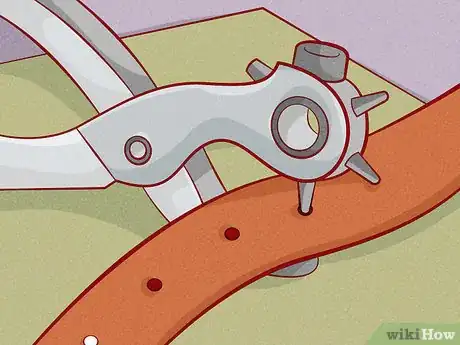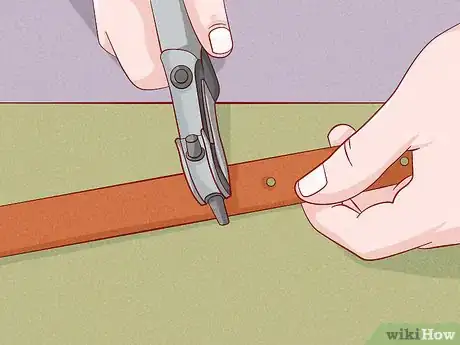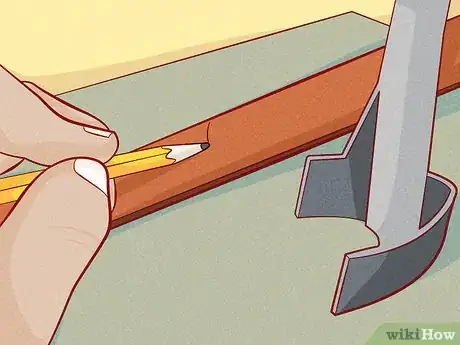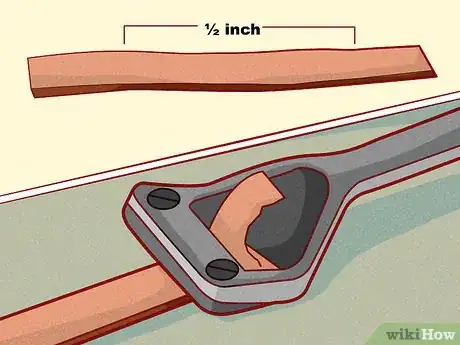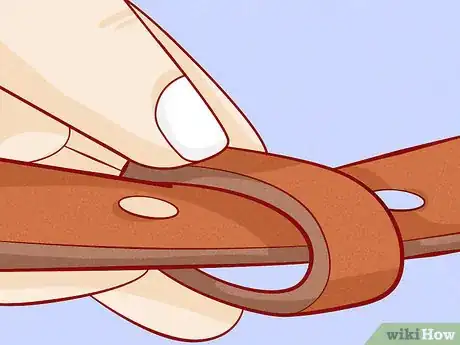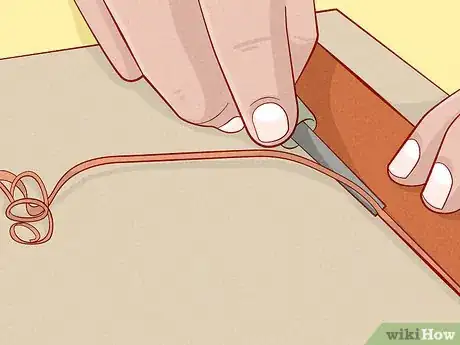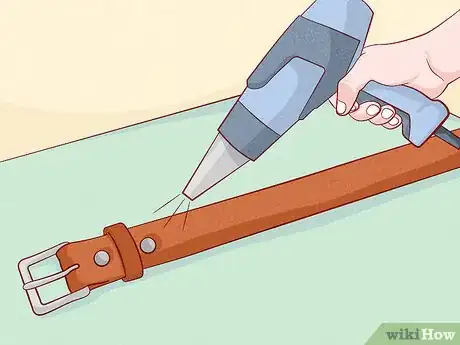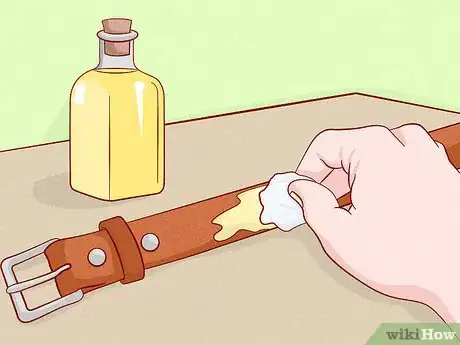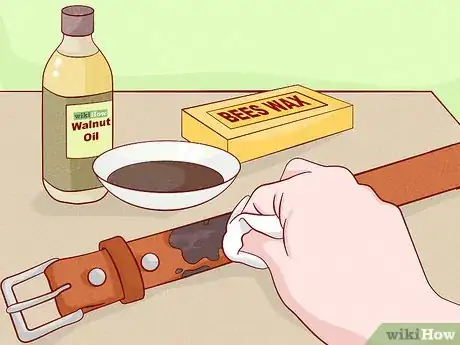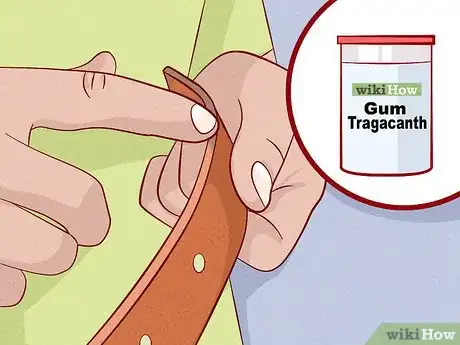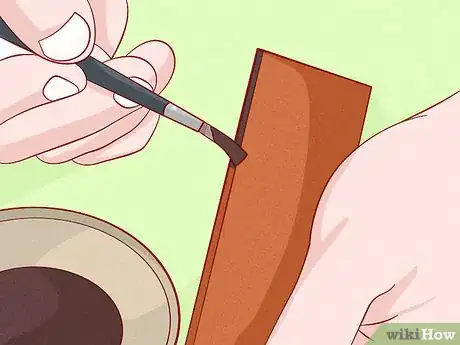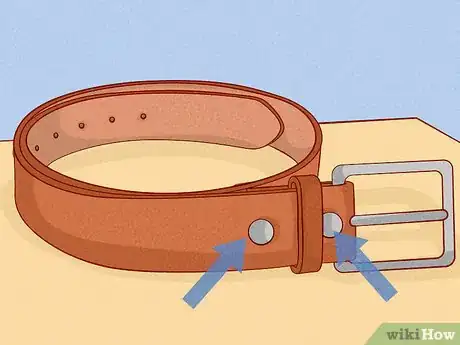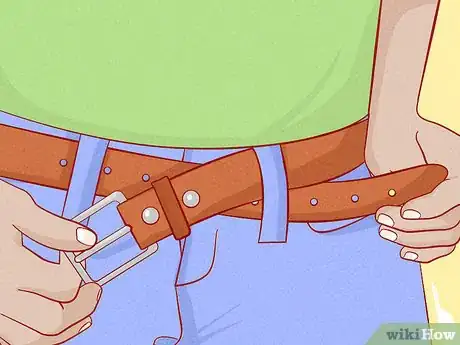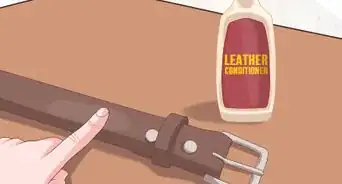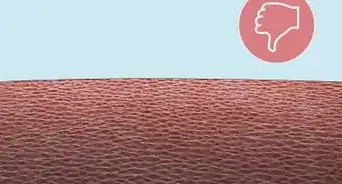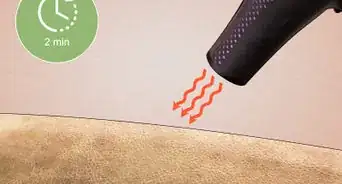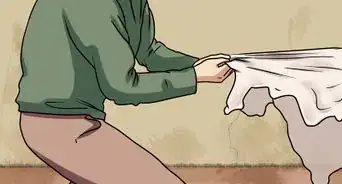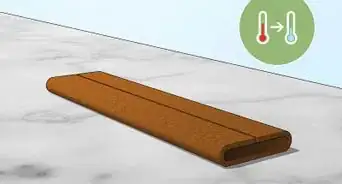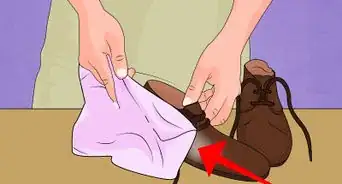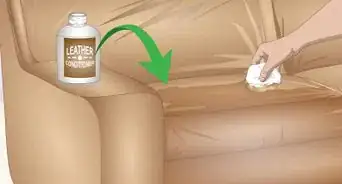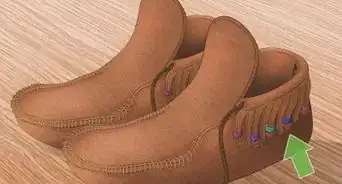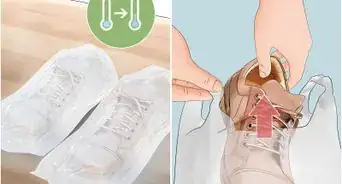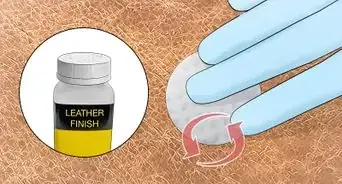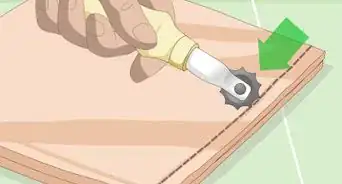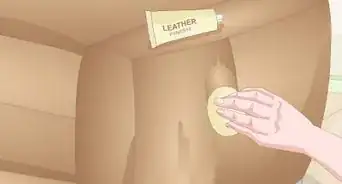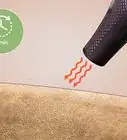This article was co-authored by wikiHow Staff. Our trained team of editors and researchers validate articles for accuracy and comprehensiveness. wikiHow's Content Management Team carefully monitors the work from our editorial staff to ensure that each article is backed by trusted research and meets our high quality standards.
This article has been viewed 46,028 times.
Learn more...
A leather belt is a fashionable accessory and sometimes necessary addition to a pair of pants. Making a leather belt may seem like a difficult process that involves an industrial process, but it doesn't have to be if you have the right tools. The leather and tools you need to make a leather belt can be found fairly easily and will usually cost less than purchasing a belt. If you are willing to spend some time practicing and working on the belt, you can have a completed belt within a day.
Steps
Preparing the Leather
-
1Measure your belt size. First, you will need to take measurements to know where to cut the leather. A simple way to do this is to put on a belt that you already have, put it on to the belt hole that fits you best, and measure the belt all the way around. You can also use a tape measurer by putting it around your hips at the place where the belt would sit and recording the measurement.[1]
- Use a measurement that feels most comfortable. If you pull the belt or measuring tape tightly, then you might end up with a belt that feels uncomfortable to wear.
-
2Obtain leather. Purchase a long piece of 8 to 9 oz. vegetable tanned leather. Any type of vegetable tanned leather will do. You can find leather online, at a tannery, or look for a leather shop in your area.[2]Advertisement
-
3Cut a straight line down the leather with your razor. You need to create a straight edge on the leather to give the strap cutter somewhere to rest. First, lay your leather out flat on a table. Then, mark straight, long line on one side of the leather. The line should be larger than the size you measured. For example, cut 45 inches for a 32-inch waist size. Finish the cut with a perpendicular cut so that the strap cutter can easily enter and exit the leather.[3]
- Use a ruler as you're cutting to make sure the line is absolutely straight.
-
4Set the thickness for the strap cutter. First, you will need to set the thickness knob on the strap cutter so the piece of leather you have fits through it. After that, you can set the thickness to whatever you prefer. A 1 ¼ inch wide belt is a safe choice.[4]
-
5Use the strap cutter. Press the strap cutter up against the straight edge you just made in the leather. Slowly feed the leather into the strap cutter. Go slowly and make sure the straight edge stays pressed up against the strap cutter. Grab the leather once it comes out of the strap cutter and pull it.[5]
- Take this step very slowly or you could end up with a piece of leather that is not straight and basically unusable.
Making the Belt
-
1Mark the placement holes for the end of the belt. The easiest way to mark the holes is to use a belt that you already have and base your holes off of the placement of those holes. You will have five holes on total. Two holes close to the tail end of the belt, one larger hole for where the fold occurs for the buckle, and two holes after that. The holes should be placed about an inch apart.[6]
- Use a pencil to mark the placement of the holes.
-
2Punch out the holes. Use your hole puncher to punch out the holes where you have made the marks. 5/64 is good to use for the size of the hole punches. Use your strap hole punch to cut out the longer holes.[7]
-
3Skive off some of the thickness where the holes are. Shaving off some of the thickness in the place where you just made the holes helps the belt fold over itself for the buckle and loops. Skive off about half of the thickness. Go slowly and make shallow cuts. Don't try to take off half of the thickness at once.[8]
- You can also use a belt sander to take off the thickness, but you are more likely to get “fuzzies” with this method.
-
4Put the buckle in place. Put the buckle in place, and fold the skived leather over itself. You do this so that you can take an actual measurement of the belt. Once the buckle is in place, measure three inches beyond the measurement you took of your waist. For example, if your waist measurement was 31 inches, then you would make a mark at the 34-inch spot. Mark the 34 inch spot because that is where the center hole will go.[9]
-
5Make more holes three inches beyond the skin measurement. Use your hole punch at 9/64 and punch a hole in the spot you made. Then, make two more hole punches on either side of the center hole. Each hole should be spaced an inch apart.[10]
- The extra holes allow you some space for breathing room.
-
6Shape the tail end of the belt. Take this time to shape the end of the belt. You can use a pencil to make a light sketch of the shape you'd like. The easiest way to get the ideal shape for the end of the belt is to use a belt tip cutter, but you can also use leather scissors.[11]
-
7Cut out the belt loop. Use the scrap leather that was cut off from the belt tip to make the belt loop. Feed the leftover leather into the cutter that should be adjusted to ½ of an inch. Then, skive the leather to about half of its thickness so that bend around the belt without a problem. [12]
-
8Make the belt loop. To figure out the length of the belt loop, put the strap of leather around the belt as if it the belt is already buckled. Put a mark at the place where the strap is overlapping by ½ and inch. Then, you can rivet the loop to secure it or sew it.
-
9Bevel the edges of the belt. Beveling the edges gives the belt a more refined look. First, use a damp sponge to dampen the edges of the belt. Then, use a beveler and glide it along the edges of the belt at a 45-degree angle. [13]
Finishing the Belt
-
1Rub on the dye. Using a vegetable based dye is recommended because it is non-toxic and won't do any harm to your skin. Use a towel or sponge to rub the dye on evenly along the entire top part of the belt. [14]
- One example of a homemade, vegetable dye is a mixture of walnut husks and water.
-
2Speed up the drying process. You don't have to, but it is better to speed up the drying of the dye because you can't use oil on the leather until it is completely dry. Use a heat gun on the entirety of the belt until it is completely dry. If you don't the oil will give the belt a blotchy look because it won't absorb evenly.[15]
-
3Rub olive oil on the leather. Leather often becomes dry and stiff when it has been worked with. Apply a thin coating of extra virgin olive oil to the top of the belt with a towel. Apply a few, thin coats. Do not use too much olive oil at once, or the belt may end up with a greasy look and feel.[16]
- It's not necessary to apply olive oil to the back of the belt.
- Keep in mind that the extra virgin olive oil will darken the leather.
-
4Apply a coat of walnut oil and beeswax. Use a towel to apply a coat of walnut oil and beeswax to the front and back of the belt. The oil and beeswax help preserve the leather and keep it flexible.[17]
- Use a nail to remove beeswax that may get stuck in the holes.
-
5Slick down the edges of the belt. Slick down the edges by applying a layer of gum tragacanth, a thickening agent made from the sap of Middle Eastern legumes. You only need to apply a thin coat to the edges of the belt. To [18]
-
6Burnish the edges. A wood burnisher is the best way to burnish the edges, but is can be a costly tool, especially if you don't plan to use it often. Another way to burnish the edges is to quickly rub canvas along the edges of the belt until you feel them heat up. This method, however, can be tiring.[19]
-
7Put the snaps in place. Snapping the end of the belt together is good because it makes the belt buckle interchangeable. You will, however, need a snap setting kit or a press to put the snap in place. Put the two snaps an inch apart near the end of the belt where the buckle will be. After the snaps are set, you can put the buck onto the belt.[20]
- You can also choose to rivet the leather together if you will not be removing the buckle. Just make sure to put the buckle in place first.
-
8Put on the belt loop. The last step to making your leather belt is to secure and place the belt loop. The belt loop should already be cut and measured. Secure the belt loop by using riveting it together with micro double sided rivets, or simply sew it together. Then, slide it onto the belt, and your leather belt is complete.[21]
Expert Q&A
-
QuestionHow do you soften stiff leather?
 Carroll KellyCarroll Kelly is a Shoe Care Specialist and the Owner of Austin Shoe Hospital in Austin, Texas. With over 37 years of experience, Carroll specializes in sustainable shoes, boots, belts, handbags, and luggage repair. Carroll graduated with a Bachelor’s degree from the University of Texas. Austin Shoe Hospital is a family-run business that started over 105 years ago from a single horse-drawn carriage. Today they are the largest and most recognized shoe repair company in the world.
Carroll KellyCarroll Kelly is a Shoe Care Specialist and the Owner of Austin Shoe Hospital in Austin, Texas. With over 37 years of experience, Carroll specializes in sustainable shoes, boots, belts, handbags, and luggage repair. Carroll graduated with a Bachelor’s degree from the University of Texas. Austin Shoe Hospital is a family-run business that started over 105 years ago from a single horse-drawn carriage. Today they are the largest and most recognized shoe repair company in the world.
Shoe Care Specialist Use a good leather conditioner, like liquid saddle soap. Saturate the belt in the product so it really gets into the fibers of the leather—this helps break down and loosen the material.
Use a good leather conditioner, like liquid saddle soap. Saturate the belt in the product so it really gets into the fibers of the leather—this helps break down and loosen the material. -
QuestionWhich leather tool belt is perfect for a carpenter?
 T. ChinsenTop AnswererHome improvement and hardware stores carry job-specific tool belts. You may have better luck getting help at a local hardware store to determine which tool belt to buy. Tools are a personal choice, so you'll have to examine your options to determine which will work best for you.
T. ChinsenTop AnswererHome improvement and hardware stores carry job-specific tool belts. You may have better luck getting help at a local hardware store to determine which tool belt to buy. Tools are a personal choice, so you'll have to examine your options to determine which will work best for you.
Warnings
- Be cautious when using cutting materials, like scissors and knives.⧼thumbs_response⧽
Things You'll Need
- Rolling razor
- Straight edge ruler
- Skiver
- Strap hole punch (1 inch long)
- Tape measurer
- Long piece of 8 to 9 oz. vegetable tanned leather
- Belt buckle
- Snaps
References
- ↑ https://www.mrlentz.com/2013/10/how-to-make-a-leather-belt/
- ↑ https://www.mrlentz.com/2013/10/how-to-make-a-leather-belt/
- ↑ http://jezebel.com/5993819/how-to-make-a-belt-from-scratch
- ↑ https://www.mrlentz.com/2013/10/how-to-make-a-leather-belt/
- ↑ https://www.mrlentz.com/2013/10/how-to-make-a-leather-belt/
- ↑ https://www.mrlentz.com/2013/10/how-to-make-a-leather-belt/
- ↑ http://jezebel.com/5993819/how-to-make-a-belt-from-scratch
- ↑ https://www.mrlentz.com/2013/10/how-to-make-a-leather-belt/
- ↑ https://www.mrlentz.com/2013/10/how-to-make-a-leather-belt/
- ↑ https://www.mrlentz.com/2013/10/how-to-make-a-leather-belt/
- ↑ https://www.mrlentz.com/2013/10/how-to-make-a-leather-belt/
- ↑ https://www.mrlentz.com/2013/10/how-to-make-a-leather-belt/
- ↑ http://jezebel.com/5993819/how-to-make-a-belt-from-scratch
- ↑ https://www.mrlentz.com/2013/10/how-to-make-a-leather-belt/
- ↑ https://www.mrlentz.com/2013/10/how-to-make-a-leather-belt/
- ↑ https://www.mrlentz.com/2013/10/how-to-make-a-leather-belt/
- ↑ https://www.mrlentz.com/2013/10/how-to-make-a-leather-belt/
- ↑ https://www.mrlentz.com/2013/10/how-to-make-a-leather-belt/
- ↑ https://www.mrlentz.com/2013/10/how-to-make-a-leather-belt/
- ↑ https://www.mrlentz.com/2013/10/how-to-make-a-leather-belt/
- ↑ https://www.mrlentz.com/2013/10/how-to-make-a-leather-belt/
About This Article
To make your own leather belt, start by using a strap cutter to cut out a leather strap from a piece of vegetable tanned leather. Make sure to feed the leather into the cutter slowly to ensure a neat, straight cut. Then, use an existing belt as a guide to mark the holes, and punch out the holes with a strap hole punch. Next, use a sponge to rub the top of the belt with a vegetable based dye, followed by a coat of walnut oil and beeswax to help preserve the leather. Finally, attach a buckle and belt loop to finish your belt. To learn more, including how to finish off the edges of your belt for a smooth look and feel, read on.

